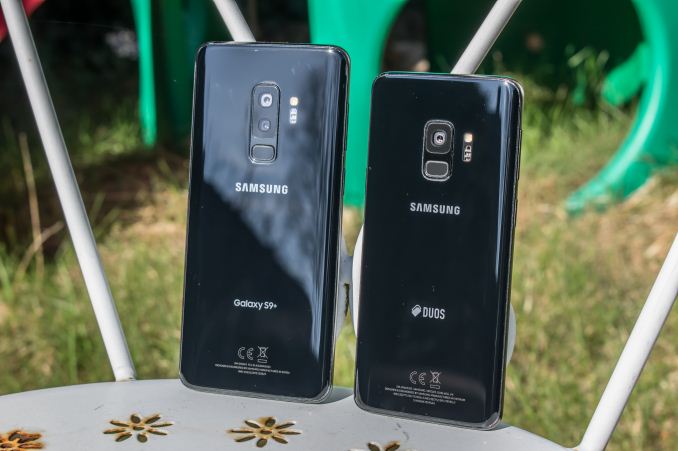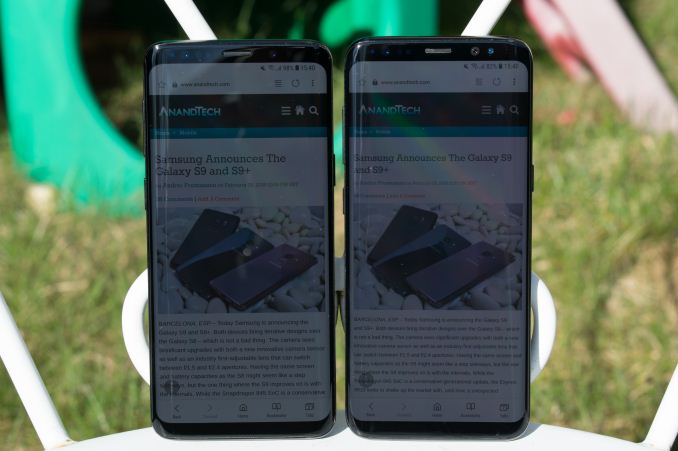The Samsung Galaxy S9 and S9+ Review: Exynos and Snapdragon at 960fps
by Andrei Frumusanu on March 26, 2018 10:00 AM ESTConclusion & End Remarks
The conclusion for the Galaxy S9 is always the toughest part to write as it’s where we have to reconcile all the pros and cons of the device and making a verdict on its value as a product to customers.
In terms of design, the S9 iterates on the S8 and I think that’s definitely a positive until Samsung somehow produces a better design overhaul. The changes we find here aren’t exactly ground-breaking and most people will get used to them very fast. The fingerprint scanner location is among the biggest ergonomics changes and while for me personally it didn’t do much, there’s plenty of people who find it an improvement.
The speaker sound quality of the Galaxy S9 is a massive improvement and this is now by far the best sounding smartphone device. The stereo speakers as well as the audio processing tuning along with the improved main speaker design all just provide a much better experience. I may not have covered this in the introduction, but Samsung’s choice to retain the 3.5mm jack is absolutely the right thing to do. I’ve got very strong feelings about companies’ rationales behind removing the headphone jack and find their reasoning either misguided or outright misleading, and just very anti-consumer choice. Here’s to hoping that Samsung sticks with it in the future, and as absurd as this is that I have to praise them for it, I have to do it to ensure that companies listen.
The screen of the Galaxy S9 holds very little surprises as it has only marginal improvements over the S8. It’s still among one of the best screens on smartphones, and honestly there’s not much more to say.
The camera of the Galaxy S9 for me had some high points and some low points. The high points are that the variable aperture of the S9 has real benefits and direct advantages in picture quality in day-light shots. The S9’s reduced usage of sharpening provided the cleanest pictures among all smartphones and thanks to its improved sensor its effective spatial resolution is actually higher than some higher resolution camera devices. The low-light shots also come with a quality improvement over the S8 – although it will depend on the lightning and scene to notice them at their full effect. Right now the S9 has the best low-light camera.
While the hardware of the S9’s camera definitely deserves praise, the software has notable issues in daylight shots. The Galaxy S9 has a very bad tendency to overexpose and compress the image’s dynamic range. In Pro mode these issues largely go away, but for the Galaxy S9 to offer a better point-and-shoot experience than the S8 or the new iPhones, Samsung needs to rework its camera calibration in Auto mode as right now it can be the odd one out in terms of results.
Finally, the biggest story for the Galaxy S9 is its big contrast in terms of SoC hardware. Ever since we first heard about the Exynos 9810 we had very large expectations and we knew there would be some tangible differences between Exynos and Snapdragon variants. The expectations couldn’t be more shattered than the results we got. While the Snapdragon 845 variant of the Galaxy S9 performed largely as advertised and as we had been told to expect by Qualcomm, the Exynos 9810 failed to live up to its hype in real-world scenarios. Effectively, the Exynos 9810 variant and as evidenced by all the data we collected, is the slower variant of the two. The root cause here has been identified as the extremely conservative scheduler and DVFS mechanisms which essentially nullify any advantage the new M3 cores have in synthetic benchmarks.
In 3D benchmarks, the Exynos 9810 posted very healthy efficiency improvements and even sometimes managed to catch up to last year’s Adreno 540 – something I hadn’t expected. Qualcomm’s new Adreno 630 raises the bar in terms of peak performance, however the promises of increased efficiency have not materialised in the commercial hardware as the performance boost comes at a cost of increased power. Effectively, when looking at sustained workloads, the Snapdragon 845 isn’t any faster than the Snapdragon 835 in its GPU department. Fortunately for Qualcomm, they’re still in the lead and this is not a deal-breaker for the Galaxy S9.
While the performance advantage of the Snapdragon 845 variant over the Exynos 9810 variant is something we could live with, the battery life results of the Exynos is definitely a deal-breaker. I’m not sure of the root cause here and whether it’s something that can be fixed by software, but showcasing such a battery runtime regression over its predecessor is universally something that we can all agree on as not acceptable for a flagship device. Based on our testing, it’s especially in heavy use-cases where this will most evident. The Snapdragon 845 variant performed as expected in the battery life tests.
Finally the recommendation of the Galaxy S9 will be based on which market you are in and which variant you’ll be able to purchase. The Snapdragon 845 variant in the US, China and Japan is a healthy upgrade over its predecessors and I don’t really have much to say against it as a phone, besides the camera exposure issues. Here Samsung iterated and perfected over the S8, and whether the S9 is worth to you as an upgrade is something you’ll need to decide based on its individual parts, because as a package, the Snapdragon S9s don’t disappoint.
For readers in markets with the Exynos variant I need to take a slightly different tone. Make no mistake as I say that the Exynos S9 is by far not a bad phone. If you come from older generation devices you will see significant upgrades, but as a flagship coming at a price premium we expect a no-compromise device, and here is where the Exynos S9 doesn’t tick all boxes. The battery life regression that we measured is the single most concerning aspect of the device. Here buyers will need to consider the device with caution and well-thought out consideration and should maybe apply a wait & see approach over the coming months – for one to see if Samsung resolves the issues via software, and secondly, to await the release of competitor’s new product lines for possible better alternatives.












190 Comments
View All Comments
Infy2 - Monday, March 26, 2018 - link
Thank you very much for a thorough phone review. I had almost lost hope that AT no long publishes such reviews!sturmen - Monday, March 26, 2018 - link
Did no one else notice the Lorem Ipsum in the "Video Evaluation" section?trenzterra - Monday, March 26, 2018 - link
I really appreciate your explanation of the black clipping issue on the S9+. Given this, is this a hardware limitation on the S9+'s panel or is it that the S9+ panels are calibrated to have darker blacks? In a not-so-dark room, I noticed that videos on the S9+ looks gorgeous whereas on my older S7 edge, I could see lots of banding in the grey areas. Was this perhaps done intentionally?jordanclock - Monday, March 26, 2018 - link
The black clipping can be mitigated by adjusting the gamma curve, which I believe can be controlled without root and certainly could be fixed with updates.name99 - Tuesday, March 27, 2018 - link
Not true. Changing a gamma curve can't change the fact that your panel's minimum "on" brightness is too bright compared too off and thereby noticeable. All changing the gamma curve will do is move where the posterization occurs.Apple's is the correct solution (dithering) for this sort of problem, until the panel hardware is refined.
StevoLincolnite - Tuesday, March 27, 2018 - link
What I am not a fan of is that aspect ratio... I watch allot of media and would have preferred to retain 16:9.Also. Glass. Ugh.
Omega244 - Monday, March 26, 2018 - link
3000 mAh (13.47Wh)non-replaceable 3500 mAh (11.55Wh)
non-replaceable
I think the battery specs are swapped on Page 1
TMCThomas - Monday, March 26, 2018 - link
Hmm that Exynos peformance and battery life is indeed quite dissapointing. I'm currently still on the Galaxy s5+ and I really wanted to upgrade to this device since it's about time right now. But I'm not going to pay such a high price for a device which has big problems with it's peformance and battery life. My s5+ also has battery life that has never actually been very good (screen on time never exceeding 3 hours mostly between 1 and 2) Device always seemed to be overheating and I couldn't play a game (at the desired performance) for longer than 10 minutes since the Adreno 420 would have dropped from 600mhz tot 240MHZ which made the framerate in the more graphicly intense games going below 30 fps Mostly around the 20fps mark. I'm not planning to go for an experience like that again. It's a shame that they don't sell the Snapdragon version here in The Netherlands. Would have for sure bought that one but i'm not so sure with the exynos variant. I really hope that they can fix these issue's with some software update (and I hope to see an update from you guys if they do ;) But I don't expect it to be honest. sigh I might be waiting another year for the s10 or sX of whatever they're going to call it, if I haven't switched to another brand by that time. We'll see how this will go but for now I'll hold of to buy one.lopri - Monday, March 26, 2018 - link
The S8 hás the best ergonomics, and the S9 might be one of the best, but I submit that S9+ is one of the worst in that regard with the protruding frame digging in the hand like a wire. The matte coating does not help in the grip, either.Zhenocnra - Monday, March 26, 2018 - link
Since when did the SD 845 have 4k video recording at 60FPS enabled on the S9 and S9+? Last time I checked, Samsung still hasn't enabled that feature on the S9 or S9+.